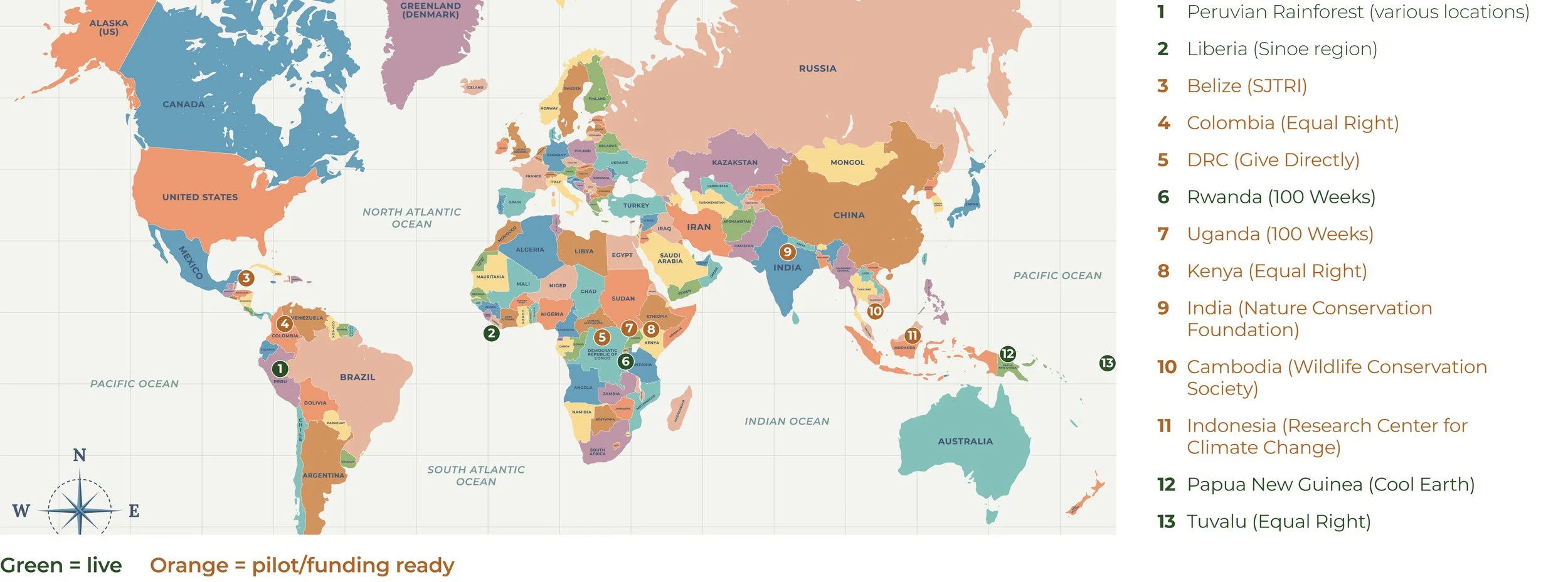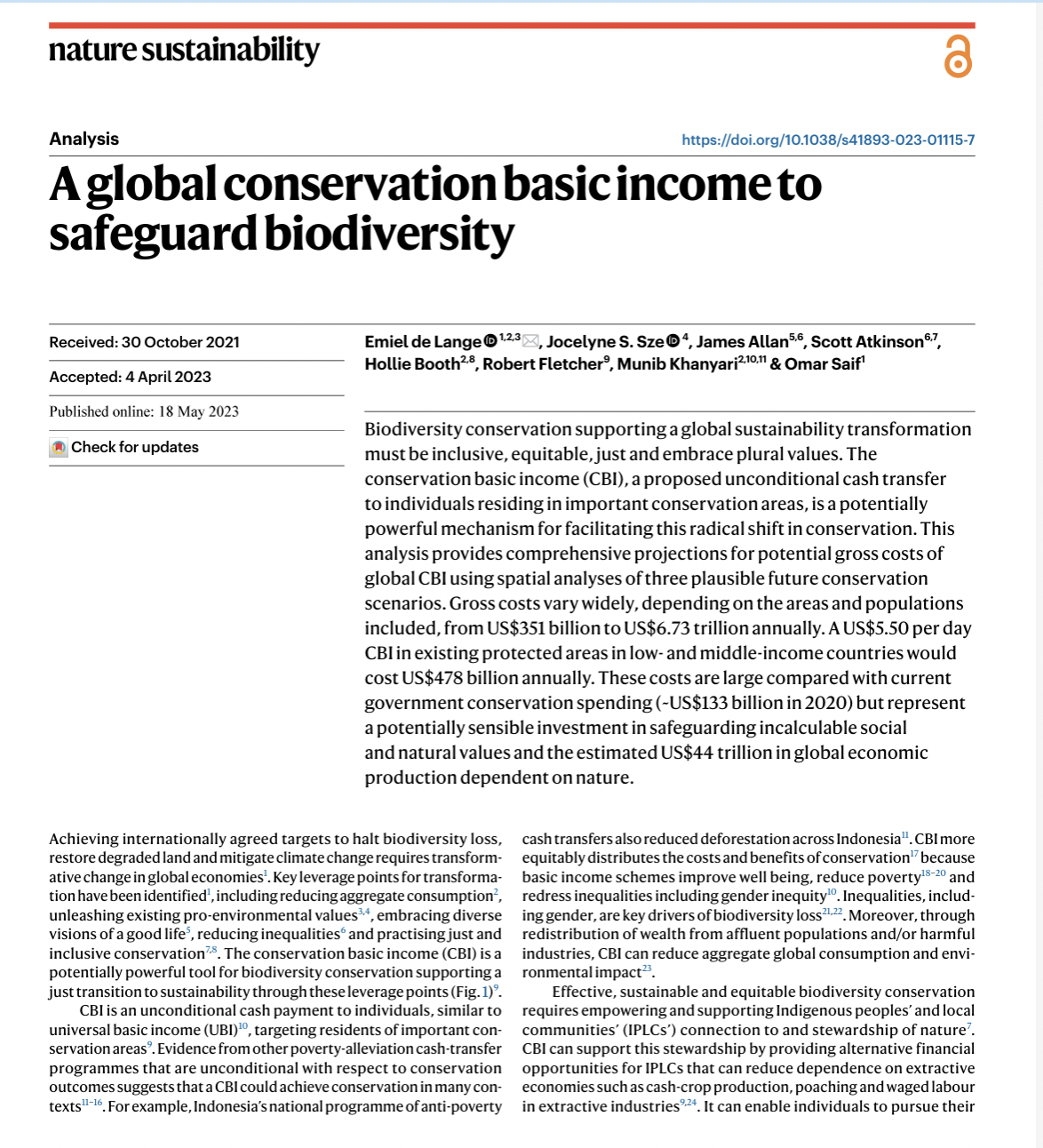Resources
Whilst the widespread use of unconditional cash transfers to achieve conservation outcomes is a relatively novel idea, there is a wealth of literature from related fields to back up this approach, as well as positive data from early-stage trials. Below, you can find some of the key information underpinning the concept, as well as where projects are happening or due to happen soon!
For a more comprehensive overview of literature associated with this work, you can also check out our folder of relevant research here.
Further details can also be found via the Basic Income for Nature and Climate Research Laboratory at Wageningen University, or by contacting our research workstream lead, Professor Robert Fletcher, at robert.fletcher@wur.nl.
Where is it happening?
Key Literature on Cash for Conservation
Frequently Asked Questions
-
Leading experts agree that current conservation and sustainability goals cannot be achieved with business-as-usual approaches.
The primary mechanisms that exist to support communities are often stymied by complex bureaucracy, take years to develop, and do not adequately compensate local communities for the services they provide, nor support them in adopting or adapting their livelihoods in ways that further preserve or restore the ecosystems in which they live.
-
Direct support to indigenous peoples and local communities (IPLCs) as custodians of nature is the most effective way to conserve vital ecosystems.
Despite international conventions and domestic laws which address the rights of IPLCs (e.g. UN Declaration on the Rights of Indigenous People; the Global Biodiversity Framework Target 22) and cover tenure, FPIC, IP, and benefit sharing in respect of revenue flows, this is not matched by reality.
Multiple publications affirm that conservation efforts led by indigenous peoples and local communities produce better ecological and social outcomes than externally controlled approaches. Increasingly, the social well-being and economic dimensions of ecosystem health are seen as inextricably linked to the ecological dimension.
Despite this, between 2011 and 2020, projects supporting IPLC tenure and forest management received less than one percent of climate change mitigation and adaptation funding from Official Development Assistance (ODA) annually. And, by 2022, only 7% of the funds committed in the COP26 Indigenous People and Local Communities (IPLC) Forest Tenure Pledge for 2021 to 2025 had been distributed to IPLC groups.
A new database on Indigenous funding shows that between 2016 and 2022, only 0.23 per cent of UK funding ostensibly earmarked for Indigenous peoples was provided directly to Indigenous organisations.
-
Unconditional cash transfers (UCTs) present a highly promising means of channelling direct assistance to IPLCs as part of a rights- and justice-based approach to conservation.
Given the inadequacy of existing approaches, experts are increasingly calling for unconditional cash transfers to advance conservation. They directly address the financial constraints faced by communities and individuals who are crucial custodians of natural ecosystems. This approach can enhance conservation outcomes by providing financial stability and empowering local communities to make sustainable choices.
To date, unconditional cash transfers have not been used systematically to advance conservation outcomes. However, Cool Earth’s programme in Peru demonstrates how a basic income is enabling Indigenous peoples who live alongside the rainforest to invest in their futures without the need to sell their land or trees. This echoes findings from GiveDirectly’s large cash transfers in e.g. Rwanda, which the organisation is currently scaling up in Liberia with a programme explicitly designed to support sustainable land use practices for forest-dependent communities.
These promising first indications align with the established evidence base from more than 300 high-quality studies on cash transfers which demonstrate that unconditional cash transfers promote investment in alternative livelihoods and stabilize and support day-to-day household needs.
There is therefore good reason to believe that cash transfers could also support communities to shift away from wildlife poaching, reduce their reliance on forests for subsistence, or avoid taking jobs in extractive industries.
-
Different models of UCTs and complementary programming will be suitable for different nature/conservation challenges.
We recognise that elements of unconditional cash transfer design - such as payment size, cadence/timing, and financing sources will profoundly influence the potential to achieve nature and conservation outcomes.
We also recognise that unconditional cash alone may not be a sufficient intervention in many contexts, but that the provision of basic economic security should be a baseline requirement for successful environmental stewardship. As such, cash should be included as a key pillar in conservation and nature programming.
More work is therefore needed to design such programmes with IPLCs, supporting them in realizing conservation goals.
-
This is an important field to evaluate and we are committed to collective evidence building
The nature of environmental outcomes in response to cash transfers (conditional or unconditional) is highly sensitive to the studied variable and local ecological, institutional, and social conditions.
Many conditional cash transfer programs effectively reduce deforestation and improve environmental outcomes. We note the significant evidence base around PES in particular, and want to build comparative evidence on unconditional models, with the aim of addressing some of the limitations of these conditional policies.
Yet many PES programmes struggle to effectively reduce rural poverty alongside environmental protection. Consequently, tensions often arise between social and environmental outcomes. Tying payments to recipients’ basic needs rather than the valuation of specific ecosystem services may help to reduce this tension.
Local conditions, including market access, the communities’ relationship with the environment, and institutional strength, are essential factors to consider when studying the environmental impacts of cash transfers.
We also want to understand the pathways for cash transfers’ influence on nature and conservation across a range of challenges and ecosystems (e.g. Deforestation/Afforestation, Revegetation, Wildlife Conservation, Coastal and Ocean management, Land use and sustainable Agriculture).










